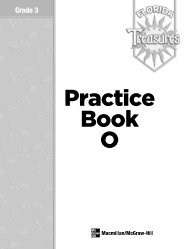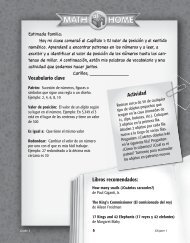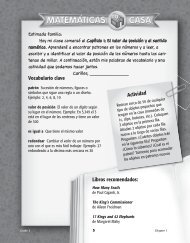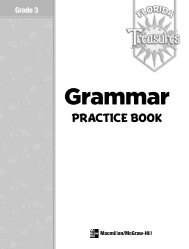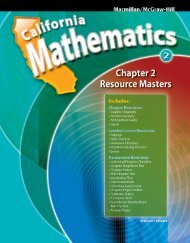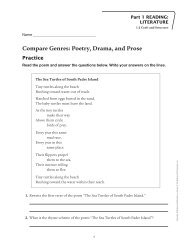Practice - Macmillan/McGraw-Hill
Practice - Macmillan/McGraw-Hill
Practice - Macmillan/McGraw-Hill
You also want an ePaper? Increase the reach of your titles
YUMPU automatically turns print PDFs into web optimized ePapers that Google loves.
© <strong>Macmillan</strong>/<strong>McGraw</strong>-<strong>Hill</strong><br />
Name<br />
A primary source is information that comes from the time being<br />
studied. Journals and letters are two types of primary sources.<br />
Journals provide daily records written by a person for his or her<br />
own use. Letters are a way for people to share information with<br />
others through writing.<br />
Use the passage to answer the questions.<br />
<strong>Practice</strong><br />
Text Features:<br />
Journals and Letters<br />
October 12<br />
The group and I arrived safely in Antarctica today. The wildlife here is<br />
wonderful! I already have seen a colony of Adelie penguins and managed to<br />
make some sketches of them in my notebook.<br />
The Adelie penguin<br />
—has a white front and a black back.<br />
—has a white ring around its eyes.<br />
—is about 30 inches tall.<br />
—weighs 11 pounds.<br />
—eats fi sh. (Must remember to learn more about their diet tomorrow.)<br />
1. What type of primary source is the passage above? How can you tell?<br />
2. In what ways does the primary source show that the author has witnessed<br />
the events described?<br />
3. Based on the passage, what is another primary source that you can expect<br />
to see with this one?<br />
At Home: Keep a journal for a week. Then write a letter to a<br />
family member summarizing the daily events in your journal.<br />
Spirit of Endurance<br />
Grade 5/Unit 5<br />
153



